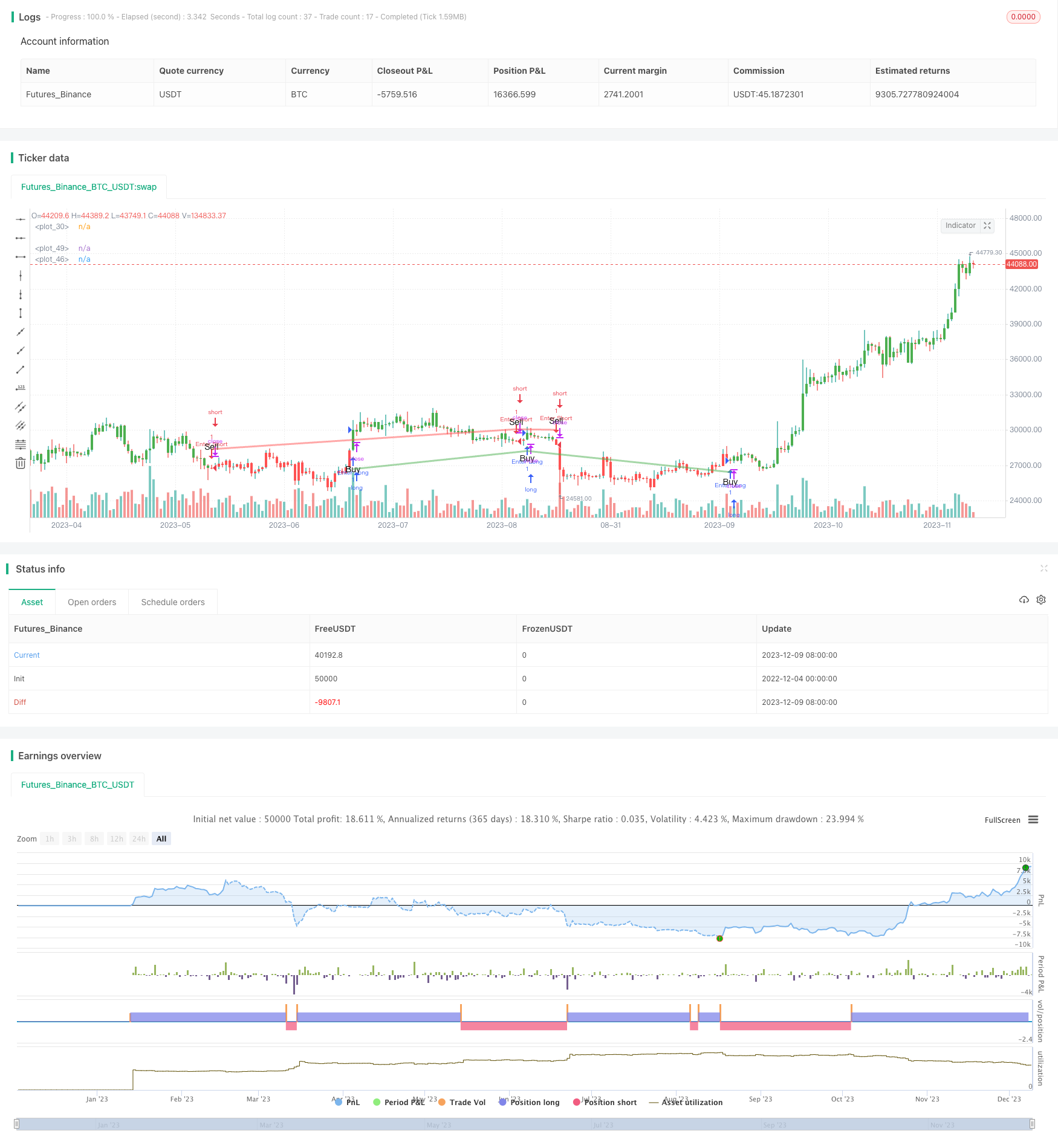
概述
该策略采用EMA均线 golden cross 生成交易信号,即快速EMA线上穿慢速EMA线时产生买入信号,快速EMA线下穿慢速EMA线时产生卖出信号,属于典型的趋势跟踪策略。同时,策略利用ATR指标设定动态止损位,在保证盈利的同时控制风险。
策略原理
- 定义快速EMA均线周期为13,慢速EMA均线周期为48。
- 当快速EMA线上穿慢速EMA线时,产生买入信号;当快速EMA线下穿慢速EMA线时,产生卖出信号。
- 通过ta.crossover和ta.crossunder函数判断均线金叉死叉。
- 采用ATR指标计算动态止损位,止损位距离为close的1.5倍ATR。
- 通过颜色变化、买卖标记、止损线直观显示交易信号和止损位。
策略优势分析
- 基于EMA均线的金叉死叉产生信号,避免错过市场主要趋势,收益较为可观。
- ATR动态跟踪止损,既确保了充分顺势获利,也控制了回撤风险,整体风险收益比较平衡。
- 直观的信号显示和止损显示,操作简单,适合多数人。
- 可调整的参数较少,容易掌握和优化。
策略风险分析
- 突发事件造成暴跌可能触发止损。
- 震荡行情中可能产生频繁无效信号。
- 参数设置不当可能导致过于激进入场或止损过于宽松。
- 需适当优化EMA参数和ATR参数。
解决方法: 1. 可适当放宽ATR倍数,确保止损离最近高点有一定缓冲。 2. 可考虑在信号产生后有确认机制,如价格突破前高点等。 3. 建议参数优化要全面考量多种市场情况。
策略优化方向
- 可以测试不同的参数组合,寻找最佳参数。
- 可以考虑加入其他指标进行信号过滤,例如成交量指标、波动率指标等,提高信号质量。
- 可以根据大级别趋势调整EMA参数,更好捕捉主要趋势。
- 可以考虑动态调整ATR止损倍数,在趋势行情中扩大止损范围。
- 可以结合机器学习算法自适应优化参数。
总结
该策略整体较为简单易用,基于EMA均线产生信号,顺势而为,再辅以ATR指标追踪止损,可以有效控制风险。虽然会有一定假信号,但捕捉主要趋势的能力较强,收益较为稳定,适合作为量化交易的基础策略之一。通过参数优化和功能扩展还具有很大的改进空间,值得深入研究。
策略源码
/*backtest
start: 2022-12-04 00:00:00
end: 2023-12-10 00:00:00
period: 1d
basePeriod: 1h
exchanges: [{"eid":"Futures_Binance","currency":"BTC_USDT"}]
*/
// This source code is subject to the terms of the Mozilla Public License 2.0 at https://mozilla.org/MPL/2.0/
// © byee322
/// This strategy uses the EMA to generate buy and sell signals with a 1.5x ATR stop loss
//@version=5
strategy("EMA Strategy with ATR Stop Loss", overlay=true)
// Define the EMA lengths as input parameters
emaLength1 = input(13, "EMA Length 1")
emaLength2 = input(48, "EMA Length 2")
// Define the moving averages
ema1 = ta.ema(close, emaLength1)
ema2 = ta.ema(close, emaLength2)
// Buy signal: EMA 1 crosses above EMA 2
buy = ta.crossover(ema1, ema2)
// Sell signal: EMA 1 crosses below EMA 2
sell = ta.crossunder(ema1, ema2)
// Define the state variable
state = 0
state := buy ? 1 : sell ? -1 : nz(state[1])
// Change the color of the candles
color = state == 1 ? color.green : state == -1 ? color.red : na
// Plot the colored candles
plotcandle(open, high, low, close, color=color)
// Plot the signals on the chart with text labels
plotshape(buy, style=shape.triangleup, color=color.new(color.green, 50), location=location.belowbar, text="Buy")
plotshape(sell, style=shape.triangledown, color=color.new(color.red, 50), location=location.abovebar, text="Sell")
// Calculate the ATR
atrVal = ta.atr(14)
// Calculate the stop loss level for buy
stopLossBuy = buy ? close[1] - 1.5 * atrVal : na
// Calculate the stop loss level for sell
stopLossSell = sell ? close[1] + 1.5 * atrVal : na
// Plot the stop loss level for buy
plot(stopLossBuy, color=color.new(color.green, 50), linewidth=3)
// Plot the stop loss level for sell
plot(stopLossSell, color=color.new(color.red, 50), linewidth=3)
if buy
strategy.entry("Enter Long", strategy.long)
else if sell
strategy.entry("Enter Short", strategy.short)